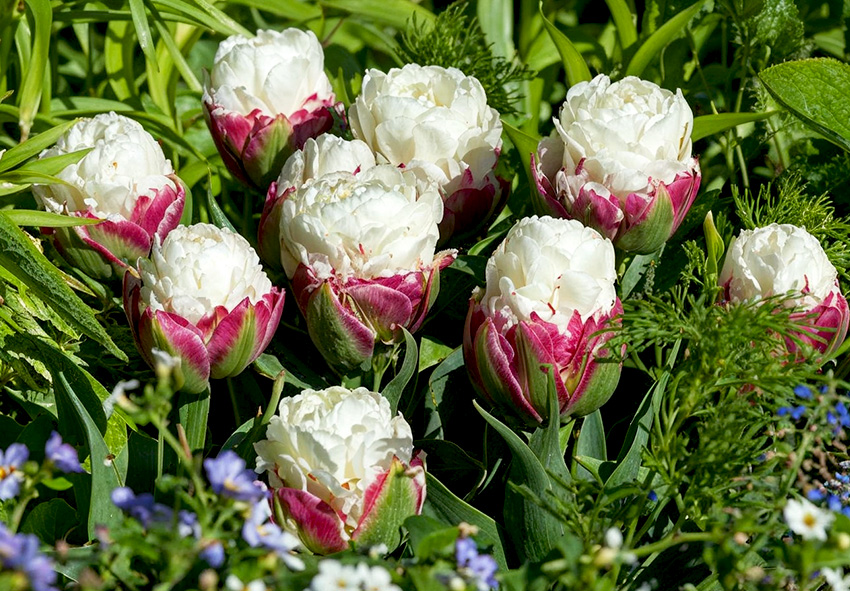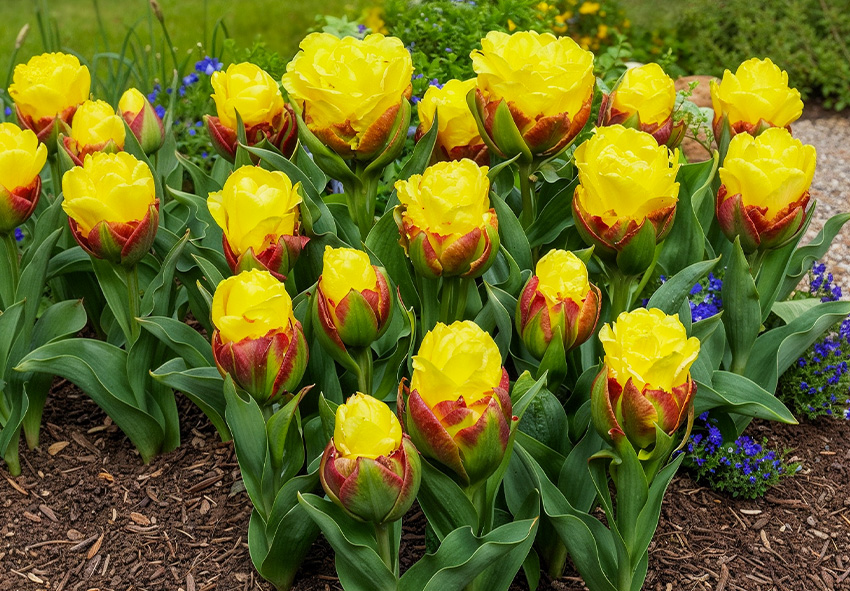Few flowers capture the imagination quite like the Ice Cream Tulip. With its layered petals resembling a scoop of vanilla ice cream resting on a cone of color, it’s one of the most striking blooms in the tulip world. Loved by gardeners for its unusual look and dependable performance, this variety is a showstopper in any spring garden.
If you’re looking for unique tulip varieties that combine playfulness and sophistication, Ice Cream Tulips are a perfect choice. Let’s explore what makes them special, the different color variations, and how to grow and care for these unforgettable spring flowers. Our gardening blog is a perfect place to find all the information you need!
What Makes Ice Cream Tulips So Special?

Ice Cream Tulips belong to the double late tulip group, known for their lush, peony-like petals and late spring bloom time. What sets them apart is their unusual color layering: soft white petals emerge from within a cup of vivid pink, yellow, or purple outer petals. The result looks just like a scoop of melting ice cream — hence the charming name.
Beyond their beauty, these tulips are long-lasting and resilient. They hold up well against cool spring winds and make excellent cut flowers for indoor displays. Their compact height, usually around 25–35 cm, also makes them perfect for borders, rock gardens, and containers.
Popular Ice Cream Tulip Varieties
The Ice Cream Tulip group includes several stunning variations, each offering its own take on the “dessert” look. Here are the five most delightful cultivars to add to your spring garden.
1. Ice Cream Tulip
The original Ice Cream Tulip is instantly recognizable for its creamy white center framed by bright pink outer petals. As the bloom opens, the center rises slightly above the surrounding petals, perfectly mimicking a scoop of vanilla ice cream. It’s a compact, sturdy tulip that performs best in full sun and well-drained soil. This variety adds elegance and whimsy to any spring display.
2. Ice Cream Banana Tulip
For a sunnier twist, the Ice Cream Banana Tulip offers cheerful yellow tones. Its creamy white inner petals sit atop vivid banana-yellow outers, creating a radiant glow in garden beds. This variety blooms slightly earlier than the classic Ice Cream and pairs beautifully with pastel tulips or white daffodils for a soft, coordinated look.
3. Ice Cream Sorbet Tulip
The Ice Cream Sorbet Tulip lives up to its name with its rich mix of magenta and lavender hues. The inner petals form a white “filling” that contrasts beautifully with the berry-toned exterior. It’s a compact, eye-catching variety ideal for containers or clustered along pathways where its colors can shine.
4. Ice Cream Cranberry Tulip
For those who love deeper shades, the Ice Cream Cranberry Tulip offers a rich, romantic look. Deep magenta outer petals wrap around a soft white center, creating a sophisticated blend of contrast. This tulip is especially stunning when planted alongside soft pink or pure white tulips for a dramatic color display in late spring.
5. Ice Cream Strawberry Tulip
The Ice Cream Strawberry Tulip brings a soft, romantic flair with layers of blush-pink and strawberry-red tones. Its gentle coloring and compact form make it a beautiful choice for cottage-style gardens and floral arrangements. When planted in groups, it creates a dreamy pastel effect that captures the essence of spring.
How to Grow Ice Cream Tulips
Though they look delicate, Ice Cream Tulips are surprisingly easy to grow. With the right conditions, you’ll enjoy strong stems, full blooms, and reliable flowering year after year.
Planting Conditions
Plant Ice Cream Tulip bulbs in autumn, around 10–15 cm deep and 10 cm apart. Choose a sunny spot with fertile, well-drained soil to prevent bulb rot. If your soil is heavy, consider adding sand or grit to improve drainage. These tulips prefer cooler climates and perform best in regions with a distinct winter chill.
Watering and Feeding

Water the bulbs immediately after planting and keep the soil lightly moist through the growing season. Avoid overwatering, as soggy soil can damage bulbs. In early spring, apply a balanced bulb fertilizer or slow-release compost to encourage large, healthy blooms. After flowering, reduce watering gradually to help bulbs enter dormancy.
Sunlight and Temperature
Ice Cream Tulips thrive in full sun, ideally receiving six or more hours of direct light daily. While they can tolerate partial shade, full sunlight enhances their color intensity and bloom shape. Cooler spring temperatures help prolong flowering time, making them perfect for northern or temperate climates.
Caring for Ice Cream Tulips After Blooming
Proper post-bloom care ensures your Ice Cream Tulips will return strong for the next spring. These double tulips store energy in their bulbs, so a bit of attention after flowering goes a long way.
Deadheading and Foliage Care
After the flowers fade, remove the spent blooms to prevent seed formation. However, allow the foliage to remain until it turns yellow and dies back naturally. This process enables the plant to photosynthesize and store nutrients for next year’s blooms.
Lifting and Storing Bulbs
In regions with hot or wet summers, it’s best to lift and store bulbs once the leaves have completely withered. Gently dig them up, clean off excess soil, and let them dry in a shaded area. Store them in a cool, dry, and ventilated space until replanting in autumn.
Design Tips for Ice Cream Tulips
Thanks to their compact shape and striking look, Ice Cream Tulips fit beautifully into many garden designs.
Ice Cream Tulips make captivating focal points in garden borders thanks to their unusual layered blooms and compact height. Their playful “scoop of ice cream” look adds charm and color contrast to mixed spring displays. Here’s how to make the most of them in your garden beds:
- Layer Colors for Contrast – Pair Ice Cream Tulips with solid-colored varieties such as pure white or deep purple tulips to make their multi-tone blooms stand out.
- Combine with Early Spring Flowers – Surround them with hyacinths, muscari, or daffodils for continuous color and fragrance throughout the season.
- Plant in Groups – Arrange 5–7 bulbs together for maximum impact; single bulbs can look lonely, but clusters create a natural “bouquet” effect.
- Use as Border Highlights – Position Ice Cream Tulips near pathways or garden edges where their unusual form can be admired up close.
- Mix Heights and Textures – Combine these double tulips with taller varieties or ornamental grasses to create depth and dynamic structure in your spring border.
The compact shape of Ice Cream Tulips also makes them ideal for container gardening. Their bold colors and fluffy blooms add a playful elegance to patios, balconies, and entryways. Try these design ideas to create your own “dessert garden” in pots:
- Choose Wide, Shallow Pots – These tulips look best when planted in broad containers that allow space for groupings and visual spread.
- Mix Color Variations – Combine Ice Cream Banana, Cranberry, and Strawberry varieties for a cheerful, layered color palette that resembles a dessert assortment.
- Add Supporting Blooms – Pair tulips with low-growing plants like pansies, violas, or alyssum to fill gaps and enhance the visual base.
- Play with Container Styles – Use vintage ceramic pots or pastel-colored planters to emphasize the playful, “ice cream” aesthetic of these blooms.
- Rotate for Even Sunlight – Turn pots every few days to ensure even growth and prevent blooms from leaning toward the light source.
Propagating Ice Cream Tulips

While Ice Cream Tulips are often admired for their beauty, gardeners can also multiply their collection over time. Propagation allows you to create new plants from existing bulbs, helping preserve your favorite unique tulip varieties year after year.
Understanding Bulb Offsets
Like most tulips, Ice Cream Tulips reproduce through bulb offsets, also known as daughter bulbs. These small bulbs form around the base of the parent bulb after flowering. Over one or two growing seasons, they can mature into full-sized bulbs capable of producing blooms. Allow offsets to grow undisturbed for at least a year before separating them for replanting.
Dividing and Storing Bulbs
To propagate through tulip bulb division, lift the bulbs once the foliage has completely withered, usually in late spring or early summer. Gently brush away soil and separate the offsets from the main bulb. Let them dry in a cool, shaded spot for a few days before storing them in a breathable mesh bag or paper container. Keep them in a dry, airy space until autumn planting.
Planting New Offsets
In autumn, replant the mature offsets about 10 cm deep in well-drained soil and full sun. Water them after planting and apply a light bulb fertilizer to encourage root development. These new bulbs may take a season or two to bloom, but with good Ice Cream tulip care, they’ll reward you with the same layered, dessert-like flowers you love.
Conclusion
With their creamy centers and colorful outer petals, Ice Cream Tulips are among the most unique tulip varieties available. They blend novelty and elegance, offering both gardeners and flower enthusiasts something truly different each spring. By following simple care steps, you can enjoy these remarkable tulips season after season — a garden treat that’s as sweet as it looks!
Frequently Asked Questions (FAQs) about Ice Cream Tulips
1. What makes Ice Cream Tulips different from other tulip varieties?
Ice Cream Tulips are unique double late tulips with white inner petals surrounded by colorful outer layers, resembling a scoop of ice cream. Their peony-like blooms and compact size make them standout garden features and excellent cut flowers. They bloom late in spring, extending color after most tulips have finished.
2. When should I plant Ice Cream Tulip bulbs?
Plant Ice Cream Tulip bulbs in autumn, ideally between September and November, before the ground freezes. This allows the bulbs to establish roots over winter. Choose a sunny, well-drained location and plant bulbs about 10–15 cm deep and 10 cm apart for best results in spring.
3. How do I care for Ice Cream Tulips after flowering?
After blooming, remove faded flowers but leave the foliage until it turns yellow naturally. This helps the bulb store energy for the next season. In warm or wet climates, lift and store bulbs in a cool, dry place, then replant them in autumn to ensure consistent blooms each year.
4. Can I order tulip bulbs from your online store?
Yes, you can order tulip bulbs from our online store Dutch-bulbs.com. We offer a wide selection of tulip varieties suitable for different climates and preferences. We take pride in providing top-quality plants that are carefully cultivated and shipped with care to ensure they reach you in perfect condition.
5. Do Ice Cream Tulips come back every year?
Ice Cream Tulips can return for several years if grown in the right conditions. They prefer cool winters and dry summers. However, in warmer regions, they may perform better as annuals. To encourage reblooming, allow foliage to die back naturally and lift bulbs for storage in hot climates.
Published: 07.11.2025
